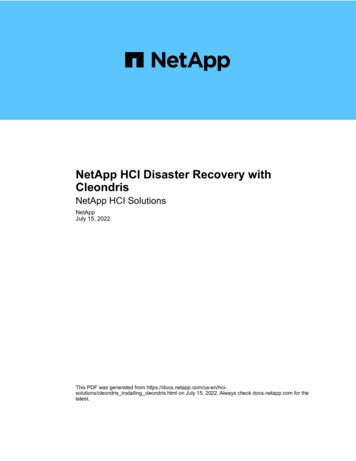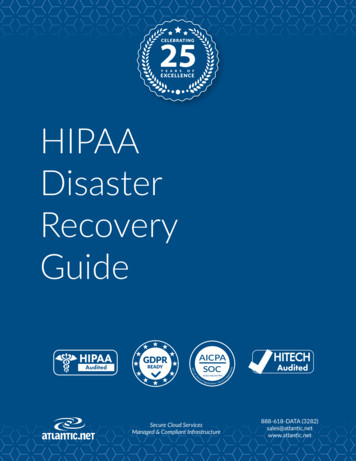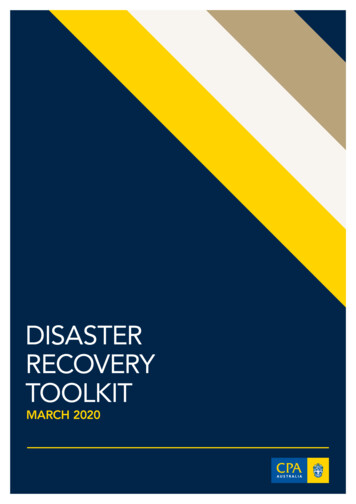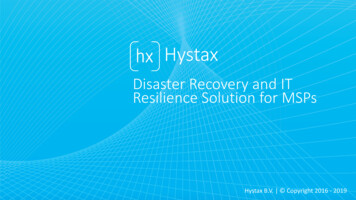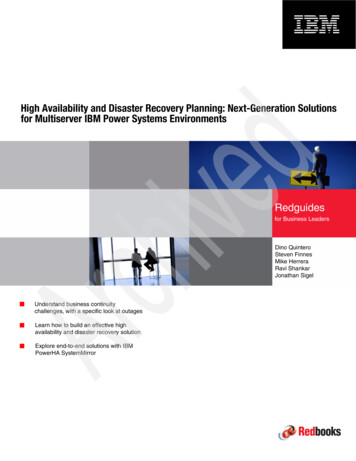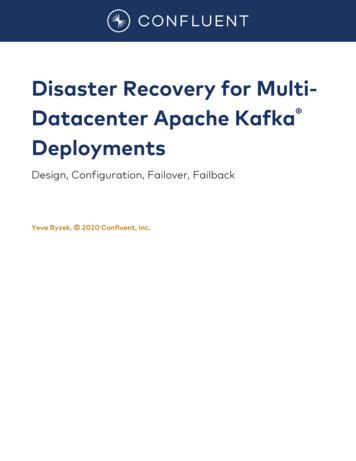
Transcription
Disaster Recovery for MultiDatacenter Apache Kafka DeploymentsDesign, Configuration, Failover, FailbackYeva Byzek, 2020 Confluent, Inc.
Table of ContentsIntroduction . . . . . . . . . . . . . . . . . . . . . . . . . . . . . . . . . . . . . . . . . . . . . . . . . . . . . . . . . . . . . . . . . . . . . . . . . . . . . . . . . 1Designs . . . . . . . . . . . . . . . . . . . . . . . . . . . . . . . . . . . . . . . . . . . . . . . . . . . . . . . . . . . . . . . . . . . . . . . . . . . . . . . . . . . . . 2Single Datacenter . . . . . . . . . . . . . . . . . . . . . . . . . . . . . . . . . . . . . . . . . . . . . . . . . . . . . . . . . . . . . . . . . . . . . . . . . . . . 2Multi-Datacenter with Confluent Replicator . . . . . . . . . . . . . . . . . . . . . . . . . . . . . . . . . . . . . . . . . . . . . . . . . . . . . . . 3Centralized Schema Management . . . . . . . . . . . . . . . . . . . . . . . . . . . . . . . . . . . . . . . . . . . . . . . . . . . . . . . . . . . . . . . 8Key Features . . . . . . . . . . . . . . . . . . . . . . . . . . . . . . . . . . . . . . . . . . . . . . . . . . . . . . . . . . . . . . . . . . . . . . . . . . . . . . 10Preventing Cyclic Repetition of Messages . . . . . . . . . . . . . . . . . . . . . . . . . . . . . . . . . . . . . . . . . . . . . . . . . . . . . . . . 10Timestamp Preservation . . . . . . . . . . . . . . . . . . . . . . . . . . . . . . . . . . . . . . . . . . . . . . . . . . . . . . . . . . . . . . . . . . . . . . 12Consumer Offset Translation. . . . . . . . . . . . . . . . . . . . . . . . . . . . . . . . . . . . . . . . . . . . . . . . . . . . . . . . . . . . . . . . . . . 13Multi-Datacenter Bringup. . . . . . . . . . . . . . . . . . . . . . . . . . . . . . . . . . . . . . . . . . . . . . . . . . . . . . . . . . . . . . . . . 17Confluent Replicator . . . . . . . . . . . . . . . . . . . . . . . . . . . . . . . . . . . . . . . . . . . . . . . . . . . . . . . . . . . . . . . . . . . . . . . . . . 17Java Consumer Applications . . . . . . . . . . . . . . . . . . . . . . . . . . . . . . . . . . . . . . . . . . . . . . . . . . . . . . . . . . . . . . . . . . . 22Confluent Schema Registry . . . . . . . . . . . . . . . . . . . . . . . . . . . . . . . . . . . . . . . . . . . . . . . . . . . . . . . . . . . . . . . . . . . . 22When Disaster Strikes . . . . . . . . . . . . . . . . . . . . . . . . . . . . . . . . . . . . . . . . . . . . . . . . . . . . . . . . . . . . . . . . . . . . 25Datacenter Failure . . . . . . . . . . . . . . . . . . . . . . . . . . . . . . . . . . . . . . . . . . . . . . . . . . . . . . . . . . . . . . . . . . . . . . . . . . . 25Failing Over Client Applications . . . . . . . . . . . . . . . . . . . . . . . . . . . . . . . . . . . . . . . . . . . . . . . . . . . . . . . . . . . . . . . . 26Reset Consumer Offsets . . . . . . . . . . . . . . . . . . . . . . . . . . . . . . . . . . . . . . . . . . . . . . . . . . . . . . . . . . . . . . . . . . . . . . 26Schema Registration . . . . . . . . . . . . . . . . . . . . . . . . . . . . . . . . . . . . . . . . . . . . . . . . . . . . . . . . . . . . . . . . . . . . . . . . . 27Failback . . . . . . . . . . . . . . . . . . . . . . . . . . . . . . . . . . . . . . . . . . . . . . . . . . . . . . . . . . . . . . . . . . . . . . . . . . . . . . . . . . . 28Restoring the Kafka Cluster . . . . . . . . . . . . . . . . . . . . . . . . . . . . . . . . . . . . . . . . . . . . . . . . . . . . . . . . . . . . . . . . . . . 28Data Synchronization . . . . . . . . . . . . . . . . . . . . . . . . . . . . . . . . . . . . . . . . . . . . . . . . . . . . . . . . . . . . . . . . . . . . . . . . 30Client Application Restart . . . . . . . . . . . . . . . . . . . . . . . . . . . . . . . . . . . . . . . . . . . . . . . . . . . . . . . . . . . . . . . . . . . . . 31Demo . . . . . . . . . . . . . . . . . . . . . . . . . . . . . . . . . . . . . . . . . . . . . . . . . . . . . . . . . . . . . . . . . . . . . . . . . . . . . . . . . . . . . . . 31Summary . . . . . . . . . . . . . . . . . . . . . . . . . . . . . . . . . . . . . . . . . . . . . . . . . . . . . . . . . . . . . . . . . . . . . . . . . . . . . . . . . . 32Appendix . . . . . . . . . . . . . . . . . . . . . . . . . . . . . . . . . . . . . . . . . . . . . . . . . . . . . . . . . . . . . . . . . . . . . . . . . . . . . . . . . . 33
Topic Naming Strategies to Prevent Cyclic Repetition . . . . . . . . . . . . . . . . . . . . . . . . . . . . . . . . . . . . . . . . . . . . . . 33Manually Reset Consumer Offsets . . . . . . . . . . . . . . . . . . . . . . . . . . . . . . . . . . . . . . . . . . . . . . . . . . . . . . . . . . . . . . 34Data Synchronization in Active-Passive Design . . . . . . . . . . . . . . . . . . . . . . . . . . . . . . . . . . . . . . . . . . . . . . . . . . . . 36
Disaster Recovery for Multi-Datacenter Apache Kafka DeploymentsIntroductionDatacenter downtime and data loss can result in businesses losing a vast amount of revenue or entirelyhalting operations. To minimize the downtime and data loss resulting from a disaster, enterprises cancreate business continuity plans and disaster recovery strategies.A disaster recovery plan often requires multi-datacenter Apache Kafka deployments where datacentersare geographically dispersed. If disaster strikes—catastrophic hardware failure, software failure, poweroutage, denial of service attack or any other event that causes one datacenter to completely fail—Kafkacontinues running in another datacenter until service is restored. A multi-datacenter solution with adisaster recover plan ensures that your event streaming applications continue to run even if onedatacenter fails.This white paper provides a general overview of a multi-datacenter solution based on the capabilities ofConfluent Platform, the leading distribution of Apache Kafka . Confluent Platform provides the buildingblocks for: Multi-datacenter designs Centralized schema management Prevention of cyclic repetition of messages Automatic consumer offset translationThis white paper will use these building blocks to walk through how to configure and bring up a multidatacenter Kafka deployment, what to do if one datacenter fails and how to failback when thedatacenter recovers.You may be considering an active-passive design (one-way data replication between Kafka clusters),active-active design (two-way data replication between Kafka clusters), client applications that readfrom just their local cluster or both local and remote clusters, service discovery mechanisms to enableautomated failovers, geo locality offerings, etc. Your architecture will vary depending on your businessrequirements, but you can apply the building blocks from this white paper to strengthen your disasterrecovery plan. 2014-2020 Confluent, Inc.1
Disaster Recovery for Multi-Datacenter Apache Kafka DeploymentsDesignsSingle DatacenterFirst, let us briefly review how a Kafka deployment in a single datacenter can provide messagedurability. The high-level reference architecture for a single datacenter is shown below.Within a single datacenter, Kafka intra-cluster data replication is the basic means for achievingmessage durability. Producers write data to and consumers read data from topic partition leaders.Synchronous data replication from leaders to followers ensures that messages are copied to more thanone broker. Kafka producers can set the acks configuration parameter to control when a write isconsidered successful.Data replication with producer setting acks all provides the strongest available guarantees, becauseit ensures other brokers in the cluster acknowledge receiving the data before the leader broker respondsto the producer. If a leader broker fails, the Kafka cluster recovers when a follower broker is electedleader and thus client applications can continue to write and read messages through the new leader.KIP-101, introduced in Kafka 0.11, hardens the intra-cluster replication protocol and addresses somecorner cases to improve fault tolerance.Additionally, client applications can connect to the Kafka cluster through any set of brokers, called 2014-2020 Confluent, Inc.2
Disaster Recovery for Multi-Datacenter Apache Kafka Deploymentsbootstrap brokers. If a client application is using a certain broker for connectivity to the cluster, and thatbroker fails, another bootstrap broker can provide connectivity to the cluster.The ZooKeeper quorum, which provides reliable distributed synchronization, is recommended to be atleast three nodes to maintain high availability even if a ZooKeeper node fails.Finally Confluent Schema Registry, which provides a globally accessible versioned history of all schemasto serve to client applications, can be run with multiple instances. One Schema Registry instance will beelected as a leader that is responsible for registering new schemas, and the remaining will be designatedas followers. Followers instances can handle read requests but will forward all write requests to theleader. In the event of a leader failure, one of the followers will be elected as the new leader SchemaRegistry instance.Taken together, the single datacenter design provides robust protection against broker failure. For moreinformation on how to configure and monitor Kafka for message durability and high availability, see theOptimizing Your Apache Kafka Deployment white paper.Multi-Datacenter with Confluent ReplicatorIn a multi-datacenter design, instead of one datacenter with one Apache Kafka deployment, there aretwo or more datacenters with Kafka deployments. Although multi-datacenter Kafka deployments havea variety of use cases, the focus of this white paper is on disaster recovery for two datacenters.Consider two Kafka deployments, each in a different datacenter in separate geographic locations. Oneor both of the deployments can be on prem, in Confluent Cloud or part of a bridge-to-cloud solution.Each datacenter has its own: Kafka cluster, such that the brokers in the local datacenter are grouped together independentlyfrom the brokers in the remote datacenter ZooKeeper quorum that only serves the local cluster Client applications that only connect to the local cluster 2014-2020 Confluent, Inc.3
Disaster Recovery for Multi-Datacenter Apache Kafka DeploymentsIn a multi-datacenter design, the goal is to synchronize data across the sites. Confluent Replicator, anadvanced feature of Confluent Platform, is the key to this design. Replicator reads data from onecluster and then writes those messages to another cluster, providing a centralized configuration ofcross-datacenter replication. New topics are automatically detected and replicated to the destinationcluster. As throughput increases, Replicator automatically scales to accommodate the increased load.While Replicator is applicable in various use cases, the focus here is disaster recovery for two Kafkaclusters. In the event of a partial or complete disaster in one datacenter, applications can failover to asecond datacenter.In the active-passive design show below, Replicator runs in one direction, copying Kafka data andconfigurations from the active DC-1 to the passive DC-2. 2014-2020 Confluent, Inc.4
Disaster Recovery for Multi-Datacenter Apache Kafka DeploymentsProducers write data to just the active cluster. Depending on the overall architecture, consumers canread data from just the active cluster, leaving the passive cluster purely for disaster recovery.Consumers can also read from both clusters to create a local cache for geo-locality. In steady state,when both datacenters are running properly, DC-1 is the active cluster and therefore all producers onlywrite to DC-1. This is a viable strategy but an inefficient use of the resources in the passive cluster. DC-1consumers can read data that originated locally in DC-1, and DC-2 consumers can read data that wasreplicated from DC-1. If a disaster event causes DC-1 to fail, the business requirements determine howthe client applications respond. Client applications can failover to DC-2. When DC-1 recovers, as part ofthe failback process, all of the latest state in DC-2 needs to be replicated back to the active clusterbefore processing can return to it.In the active-active design shown below, one Replicator copies Kafka data and configurations fromorigin DC-1 to destination DC-2, and another Replicator copies Kafka data and configurations fromorigin DC-2 to destination DC-1. 2014-2020 Confluent, Inc.5
Disaster Recovery for Multi-Datacenter Apache Kafka DeploymentsProducers write data to both clusters: DC-1 producers write to topics in their local DC-1, and DC-2producers write to topics in their local DC-2. Depending on how the client applications are written, DC-1consumers can read data that was produced in DC-1, while reading data that was produced in DC-2and then replicated to DC-1, and vice versa. Consumers are able to subscribe to multiple topics either byexplicitly naming topics or using wildcards. Consequently, the resources in both datacenters are wellutilized. In the event of a disaster event that causes DC-1 to fail, existing DC-2 producers and consumerscan continue operating, so it essentially remains unaffected. When DC-1 recovers, as part of the failbackprocess, client applications can point back to the active cluster.Data and Metadata ReplicationData replication within a single Kafka cluster is synchronous, meaning that a producer gets commitacknowledgment after data is replicated to local brokers. Meanwhile, Replicator copies messagesbetween datacenters asynchronously. This means that the client application that produces themessages to the local cluster does not wait for commit acknowledgment from the remote cluster, andReplicator copies the data after it has been committed locally. This asynchronous replication generallyminimizes latency by making data available to consumers sooner. Another benefit of asynchronousreplication is you are not creating an interdependence between two distinct datacenters. Producersends to the local cluster will succeed even if connectivity between the clusters failed or you needed todo maintenance on a remote datacenter.Replicator copies not just topic data but also metadata. As topic metadata or partition count changesin the origin cluster, Replicator makes the same the changes in the destination cluster. To maintainconsistency in the Kafka topic administrative preferences between the multiple clusters, topic metadatamust be the same in the origin cluster and the destination cluster. This is done automatically byReplicator. It creates initial topic configurations to bootstrap topics, and it synchronizes topic metadata 2014-2020 Confluent, Inc.6
Disaster Recovery for Multi-Datacenter Apache Kafka Deploymentsbetween clusters if it changes. For example, if you update a topic’s configuration property in DC-1 (e.g.,segment.bytes, which controls the segment file size for the topic’s log files), Replicator makes thecorresponding configuration update to the replicated topic in DC-2.MirrorMakerYou may have heard of a legacy standalone tool called MirrorMaker that copies data between twoKafka clusters. However, MirrorMaker has a long list of shortcomings that make it challenging to buildand maintain multi-datacenter deployments, including: Cumbersome API for filtering topics to be replicated Topics created in the destination cluster may have a configuration that does not match the topicsin the origin cluster Topic configuration changes in the origin cluster are not detected and propagated to thedestination cluster Lack of built-in capability to reconfigure the names of topics to prevent cyclic repetition of data Inability to scale replication processes as Kafka traffic increases with a single configuration Monitoring end-to-end latency across the clustersConfluent Replicator addresses these shortcomings while providing reliable data replication. Replicatorprovides better topic data and metadata synchronization across multiple datacenters. BecauseReplicator integrates with Kafka Connect, it provides superior availability and scalability.Additionally, Confluent Control Center can manage Replicator and monitor its performance, throughputand latency. To monitor Replicator performance with Control Center, you will need to configureConfluent Monitoring Interceptors.For a more in-depth comparison between Confluent Replicator and MirrorMaker, read thedocumentation. 2014-2020 Confluent, Inc.7
Disaster Recovery for Multi-Datacenter Apache Kafka DeploymentsCentralized Schema ManagementSchemas need to be available globally so that Kafka messages can be produced and consumed acrossall clusters. Schema Registry provides central schema management and is designed to be distributed.Multiple Schema Registry instances deployed across datacenters provide resiliency and high availability,and any instance can communicate schemas and schema IDs to Kafka clients. There is a commit log forthe database with all the schema information, which gets written to a Kafka topic. In a single-leaderarchitecture, only the leader Schema Registry instance writes to that Kafka topic. The followers forwardnew schema registration requests to the leader.In an multi-datacenter design, all of your Schema Registry instances in both datacenters should have:Access to the same schema IDs:Schema information must be available to both datacenters, because a message produced in DC-1 mayneed to be consumed in DC-2. A producer in DC-1 will register the schema with Schema Registry andinsert the schema ID into the message. Then a consumer in DC-2 or any other datacenter can use themessage’s schema ID to look up the schema from the Schema Registry. Both the producer andconsumer should be using the same source of truth (i.e., same Schema Registry cluster) for schemainformation.Coordinated elections for leader Schema Registry instance:Regardless of whether your multi-datacenter design is active-active or active-passive, designate oneKafka cluster as primary for Schema Registry. That cluster coordinates leader election among theSchema Registry instances. Since Confluent Platform version 4.0, either the Kafka group protocol orZooKeeper can coordinate the leader election. Use the Kafka group protocol if connecting to ConfluentCloud or if access to ZooKeeper is otherwise unavailable. In versions prior to 4.0, only ZooKeeper cancoordinate election. The remainder of this white paper shows the Kafka group protocol to coordinateleader election. 2014-2020 Confluent, Inc.8
Disaster Recovery for Multi-Datacenter Apache Kafka DeploymentsReplicator copies the Kafka topic that backs up the schema information from the primary cluster to theother cluster, as shown in the diagram above. However, all follower Schema Registry instances in bothdatacenters subscribe directly to the schema topic in the designated primary cluster. Always ensure thatthe primary Kafka cluster and leader-eligible Schema Registry instances are globally accessible by allinstances in both datacenters. 2014-2020 Confluent, Inc.9
Disaster Recovery for Multi-Datacenter Apache Kafka DeploymentsKey FeaturesPreventing Cyclic Repetition of MessagesIn active-active multi-datacenter designs where topics are replicated bidirectionally across Kafkaclusters, it is important to prevent cyclic repetition of messages. What you don’t want to happen is aninfinite loop copying a topic’s messages from DC-1 to DC-2, and then copying those same messages inDC-2 back to DC-1, and then again from DC-1 to DC-2.You can use a new feature introduced in Confluent Replicator version 5.0.1 that prevents this cyclicreplication of messages without the constraint of unique topic names. If this feature is enabled,Replicator tracks provenance information—cluster and topic origin—on a per-message basis. Replicatoruses Kafka headers, a new capability provided by KIP-82, to track provenance information and ensurethat messages are not copied to the destination cluster if they originated there. Kafka headers aresupported on brokers running Kafka version 0.11 or higher. The broker configuration parameter to set iscalled log.message.format.version, and its default is already the desired setting 2.0, so leave it as is.To enable this Replicator feature, configure provenance.header.enable true. Replicator then putsthe provenance information in the message header after replication. The provenance informationincludes the following: ID of the origin cluster where this message was first produced Name of the topic to which this message was first produced Timestamp when Replicator first copied the recordBy default, Replicator will not replicate a message to a destination cluster if the cluster ID of thedestination cluster matches the origin cluster ID in the provenance header, and the destination topicname matches the origin topic name in the provenance header. Consider the diagram below. For a giventopic of the same name that exists in both the origin and destination cluster, message m1 was originallyproduced to DC-1, and message m2 was originally produced to DC-2. 2014-2020 Confluent, Inc.10
Disaster Recovery for Multi-Datacenter Apache Kafka DeploymentsFor a Replicator instance copying messages from topic topic1 in DC-1 to topic topic1 in DC-2: m1 is copied to DC-2 because the message header in DC-1 does not have any provenanceinformation in its header m2 is not copied to DC-2 because the message in DC-1 already indicates DC-2 and topic1 as itsoriginThe inverse is true for Replicator instances copying messages from DC-2 to DC-1: m1 is not copied to DC-1 because the message in DC-2 already indicates DC-1 and topic1 as itsorigin m2 is copied to DC-1 because the message header in DC-2 does not have any provenanceinformation in its headerConsequently, applications in different datacenters can access topics with exactly the same name whileReplicator automatically avoids cyclic repetition of messages.Client applications should be designed to take into consideration the effect of having the same topicname span datacenters. Producers do not wait for commit acknowledgment from the remote cluster,and Replicator asynchronously copies the data between datacenters after it has been committedlocally. If there are producers in each datacenter writing to topics of the same name, there is no "globalordering," which means there are no message ordering guarantees for data that originated fromproducers in different datacenters. Also, if there are consumer groups in each datacenter with the samegroup ID reading from topics of the same name, in steady state they will be reprocessing the samemessages in each datacenter.In some cases, you may not want to use the same topic name in each datacenter. This may be be due toany of the following reasons: Replicator is running a version less than 5.0.1 Kafka brokers are running a version prior to Kafka 0.11 that does not yet support messageheaders 2014-2020 Confluent, Inc.11
Disaster Recovery for Multi-Datacenter Apache Kafka Deployments Kafka brokers are running Kafka version 0.11 or later but have less than the minimum requiredlog.message.format.version 2.0 for using headers Client applications are not designed to handle topics with the same name across datacentersFor these situations, please see the section in the Appendix Topic Naming Strategies to Prevent CyclicRepetition.Timestamp PreservationWithin a given cluster, Kafka consumers track their consumption of messages. They can identify theoffset of the next message to be read so that if they stop and have to continue later, they can startwhere they left off. These consumer offsets are stored in a Kafka topic called consumer offsets.With multi-datacenter, if a consumer stops in one cluster due to a disaster event, it may need to restartin another cluster. Ideally the new consumers start where old consumers left off. It may be tempting touse Replicator to copy the consumer offsets topic. However, this will not work because there aresituations where an offset for a message in one datacenter may not be the same as the offset of thesame message in a different datacenter. These situations include the following: The origin cluster may have garbage collected some messages due to the retention policy orcompaction, before they could be replicated. This may occur if Replicator had been started longafter data was written into the origin cluster, in which case offsets will never match. There may be transient errors in copying data from the origin to destination Kafka cluster. In theevent of these transient errors, Replicator will resend the data, though there is a chance forduplication. As a result of possible duplicate messages, the same offset value may no longercorrespond to the same message. Replication of the data topic may lag in replication of the consumer offsets topic. This issue mayarise because the consumer offsets topic is replicated independently from the data topics. Sowhen a consumer is restarted in the new cluster, it may try to read from an offset for which topicdata has not yet been replicated.Because of these possible situations, applications cannot use consumer offsets as the basis foridentifying the same message in two different clusters. In fact, the consumer offsets topic shouldnot be replicated between datacenters. Instead, Replicator can use the message creation timestamp,which is the original producer’s create time of the message. While copying the data, Replicator preservesthe timestamps of the messages across clusters. KIP-33 added a time-based index file to correlatetimestamps to offsets.The diagram below shows a message m1 replicated from DC-1 to DC-2. The message offset differsbetween the clusters but the timestamp t1 is preserved. 2014-2020 Confluent, Inc.12
Disaster Recovery for Multi-Datacenter Apache Kafka DeploymentsKafka brokers should be configured to preserve message timestamps based on when producers createmessages. The configuration parameter is called log.message.timestamp.type and its default isalready the desired setting CreateTime, so leave it as is. For compressed messages, the create time ofthe wrapper message will be the create time of the first compressed message.When the Kafka brokers preserve timestamps in their messages, consumers can reset messageconsumption to some previous point in time. In the next section, this white paper will discuss howconsumers can use these preserved timestamps to reset their offsets.Consumer Offset TranslationWhere to Resume After FailoverIf there is a disaster, consumers must restart to connect to a new datacenter. Whereas before thedisaster they consumed messages from topics in one datacenter, now they consume messages fromtopics in the other datacenter. 2014-2020 Confluent, Inc.13
Disaster Recovery for Multi-Datacenter Apache Kafka DeploymentsHow do the consumers that failed over to the other datacenter determine from where in the topic theyshould start reading? They could start at the earliest message of each topic, at the latest message or atthe last known good time before the disaster event, which is close to the last time a message may havebeen consumed.Consider a producer that may have written 10000 messages to a topic in DC-1. Replicator copies thosemessages to DC-2. Given replication lag, it copied 9998 messages when the disaster occurred. It couldbe that the original consumer in DC-1 read only 8000 of those messages before the disaster event,leaving 2000 messages unread. After failover to DC-2, the consumer sees a topic with 9998 messages,the last 1998 of which were unread. So where should the consumer start reading messages?By default, when a consumer is created in DC-2, the configuration parameter auto.offset.resetcould be set to either latest or earliest:Value of auto.offset.resetEffect on the consumer that failed over to DC-2latest (default)Starts consuming from the latest message, and thus loses the last1998 messagesearliestStarts consuming from the first message, and thus reprocesses thefirst 8000 messagesFor some applications, it may be acceptable to start at either the latest message (e.g., for clickstreamanalytics or log analytics) or earliest message (e.g., for anything idempotent or anything that can beduplicated). However, for other applications, neither of these two options may be acceptable. Thedesired behavior may be that the consumer starts at message 8000 and consumes just the unread1,998 messages, as shown below. 2014-2020 Confluent, Inc.14
Disaster Recovery for Multi-Datacenter Apache Kafka DeploymentsTo do this, the consumer needs to reset its consumer offsets to something meaningful in the newdatacener. As discussed in the section Timestamp Preservation, consumers cannot reset theirconsumption by exclusively relying on offsets to determine where to start because the offsets maydiffer between clusters. Offsets may vary between datacenters, but timestamps will not. Withtimestamp preservation in the messages, it is the timestamp that has similar meaning between theclusters, and a consumer can start consumption at an offset that is derived from a timestamp.Confluent Platform version 5.0 introduces a new feature that automatically translates offsets usingtimestamps so that consumers can failover to a different datacenter and start consuming data in thedestination cluster where they left off in the origin cluster. To use this capability, configure Javaconsumer applications with an interceptor called Consumer Timestamps Interceptor, which preservesmetadata of consumed messages including: Consumer group ID Topic name Partition Committed offset TimestampThis consumer timestamp information is preserved in a Kafka topic called consumer timestampslocated in the origin cluster. Replicator does not replicate this topic since it has only local clustersignificance.As Confluent Replicator is copying data from one datacenter to another,
information on how to configure and monitor Kafka for message durability and high availability, see the Optimizing Your Apache Kafka Deployment white paper. Multi-Datacenter with Confluent Replicator In a multi-datacenter design, instead of one datacenter with one Apache Kafka deployment, there are two or more datacenters with Kafka .





